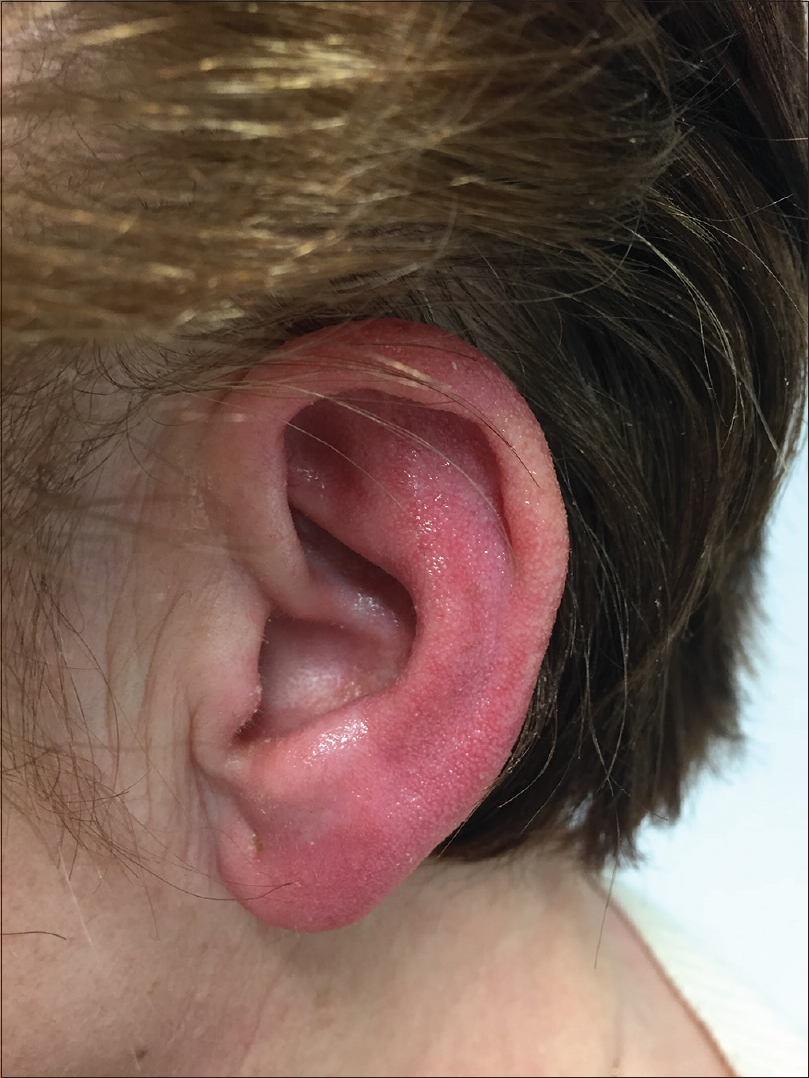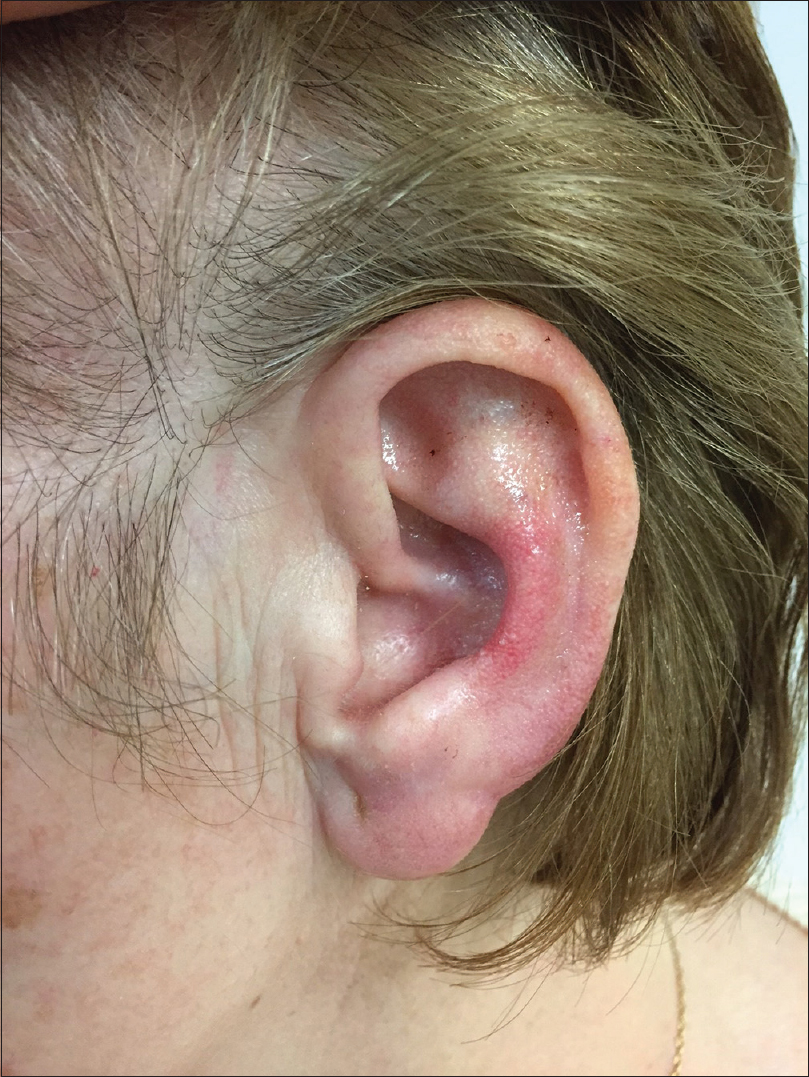Translate this page into:
Successful treatment of red ear syndrome with botulinum toxin type A
2 Department of Pathology, Del Sureste Hospital Arganda Del Rey, Madrid, Spain
Correspondence Address:
Maria Castellanos-Gonzalez
Calle Sánchez Pacheco, 75, 1C, 28002, Madrid
Spain
| How to cite this article: Castellanos-Gonzalez M, De Manueles F, Martos MG, Rodríguez MA. Successful treatment of red ear syndrome with botulinum toxin type A. Indian J Dermatol Venereol Leprol 2019;85:107-108 |
Sir,
Red ear syndrome is characterized by recurrent unilateral or bilateral, paroxysmal attacks of redness, pain and burning sensation of the external ear. The visibility of skin lesions, the symptoms, as well as the absence of satisfactory treatment causes immense suffering to patients with this medical condition. An elderly woman reported with unilateral red ear syndrome. She was treated with botulinum toxin type A which showed a very good response. We propose this treatment as a safe and effective therapeutic option for red ear syndrome.
A 69-year-old woman presented with a history of recurrent monthly attacks of redness and burning sensation of the left external ear for past 6 years. Physical examination revealed intense erythema without edema of the left external ear. There was no local rise in temperature, vesicles or erosions. The external auditory duct was spared [Figure - 1].
 |
| Figure 1: Erythema on the left ear without edema |
Laboratory tests, microbiological cultures and epicutaneous tests did not show any relevant findings. A biopsy demonstrated moderate, chronic inflammatory infiltrate in dermis. Cartilage was not affected. A red ear syndrome was therefore diagnosed.
A neurologic and otorhinolaryngologic evaluation was conducted to look for some possible causes. Nuclear magnetic resonance and otoscopy were done, but no significant findings were found. The patient was previously evaluated for headaches and cervical arthrosis was diagnosed with a nuclear magnetic resonance of the head and neck.
As there was no response to several treatments (emollients, topical corticosteroids, topical tacrolimus, topical ivermectin, ibuprofen and tricyclic antidepressants), botulinum toxin type A injection was offered to this patient. The toxin was reconstituted before use with 2.5 ml of sterile 0.9% sodium chloride added to the 100unit vial. An insulin syringe with a 30G needle was used for the injections. A total of 45 units of botulinum toxin type A was injected. No topical anesthesia was used for this procedure. The number of injections was nearly 10 with a space of 0.5 cm between each. A very good response with improvement of erythema and discomfort was observed within 3 days, peak in 2 or 3 weeks [Figure - 2] and gradually declined after 5 months. The patient complained of recurrence of symptoms during a follow-up visit after 9 months.
 |
| Figure 2: Erythema on the left ear reduced after botulinum neurotoxin type A injection |
Red ear syndrome was initially described in the literature by Lance in 1994.[1] This entity consists of recurrent attacks of unilateral or bilateral erythema of the external ear, accompanied by burning sensation, pain or increased local temperature without significant edema. The frequency and duration of attacks are variable and may be precipitated by touch or abrupt changes in temperature. Although the etiopathology is unknown, there are many reports describing a possible relationship with different types of headaches or other neurological disorders. Dysregulation of sympathetic outflow, upper cervical pathology, glossopharyngeal and trigeminal neuralgia, temporomandibular jaw dysfunction and thalamic syndrome have been described as possible pathogenic mechanisms.[2],[3] In our patient, the cervical arthrosis and headaches may have played a role in the development of the red ear syndrome.
There are no established recommendations for treatment and it is considered a therapeutic challenge for physicians.[4] Apart from cosmetic procedures injection of botulinum toxin type A is also used in the management of migraine or headache. Botulinum toxin type A acts by affecting the neuronal signalling pathways activated during a headache. It also has a blocking action on the parasympathetic nervous system and might inhibit the release of other neurotransmitters or affect the transmission of afferent neuronal impulses. In addition, it can be used to reduce erythema in rosacea.[5] In our patient, we obtained not only a complete resolution of erythema but also a significant reduction of discomfort.
Red ear syndrome is a therapeutic challenge to dermatologists because no satisfactory treatment is available to date. We report a woman with unilateral red ear syndrome with a very good response to botulinum toxin type A. We propose this treatment as a promising and safe therapeutic option for this medical condition.
Declaration of patient consent
The authors certify that they have obtained all appropriate patient consent forms. In the form, the patient has given her consent for her images and other clinical information to be reported in the journal. The patient understands that name and initials will not be published and due efforts will be made to conceal identity, but anonymity cannot be guaranteed.
Financial support and sponsorship
Nil.
Conflicts of interest
There are no conflicts of interest.
| 1. |
Lance JW. The mystery of one red ear. Clin Exp Neurol 1994;31:13-8.
[Google Scholar]
|
| 2. |
Lisotto C, Mainardi F, Maggioni F, Zanchin G. O003. Red ear syndrome: A new form of trigeminal autonomic cephalalgia? J Headache Pain 2015;16:A127.
[Google Scholar]
|
| 3. |
Lambru G, Miller S, Matharu MS. The red ear syndrome. J Headache Pain 2013;14:83.
[Google Scholar]
|
| 4. |
Wollina U. Three orphans one should know: Red scalp, red ear and red scrotum syndrome. J Eur Acad Dermatol Venereol 2016;30:e169-e170.
[Google Scholar]
|
| 5. |
Park KY, Hyun MY, Jeong SY, Kim BJ, Kim MN, Hong CK, et al. Botulinum toxin for the treatment of refractory erythema and flushing of rosacea. Dermatology 2015;230:299-301.
[Google Scholar]
|
Fulltext Views
12,003
PDF downloads
3,506





